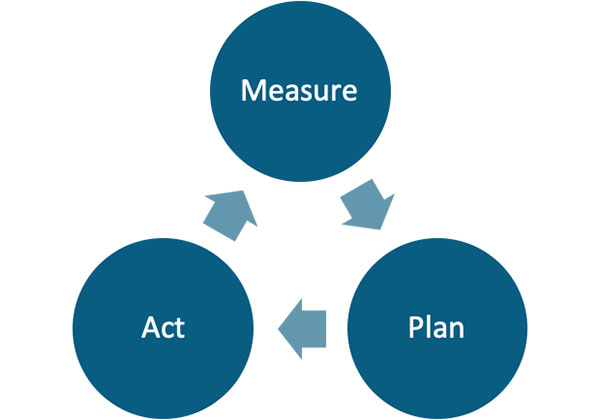John Wanamaker, founder of the country’s first department store, Wanamaker’s, once said, “Half the money I spend on advertising is wasted; the trouble is I don’t know which half.” If you feel as perplexed by how to measure the effectiveness of marketing efforts as one of the fathers of modern advertising once was, then read on to learn how to measure and improve not just marketing efficiency, but marketing effectiveness.
A Definition of Both
Marketing efficiency is optimizing how you do the right things. Marketing effectiveness is optimizing what you do so you do more of the right things.
What is Marketing Effectiveness?
Marketing effectiveness goes beyond generating a positive return on marketing investment. Ultimately, it is about creating long-term strategic value for your healthcare organization: increasing profitability, gaining market share, and strengthening the brand.
To achieve these outcomes, you should seek to improve:
- Positioning
- Product/Service
- Audience
- Message
- Price
- Promotion (communication channels)
- Placement (distribution channels)
Here’s an example: Let’s say you’ve invested in an OTT (connected TV) campaign to increase brand awareness. You may have everything right (message, audience, channel, etc.) but unfortunately, the amount of money you can commit to the campaign would deliver insufficient reach and frequency. Should you proceed? If you do, your investment would be wasted because you wouldn’t have purchased enough reach and frequency to increase brand awareness.
Instead, to improve effectiveness, consider these options:
- Narrow your targeting to reduce the audience size until your current level of investment delivers acceptable reach and frequency (but will the audience still be large enough to be meaningful?).
- Increase your investment to achieve sufficient reach and frequency (but does the company have the capacity to properly invest?).
- Reallocate your investment to other tactics with the potential to move the needle on brand awareness. In other words, are there viable alternatives that you have the capacity to execute?.
Each option has advantages and disadvantages, and many factors will affect how you make this decision.
What is Marketing Efficiency?
Performance indicators such as Cost per Acquisition and Conversion Rate are measurements of marketing efficiency. It's about squeezing every bit of performance out of your marketing tactics and campaigns.
Examples of initiatives to improve marketing efficiency:
- Reduce e-commerce cart abandonment
- Increase email open rate
- Improve SERP rankings for targeted keywords
- Increase CTR on paid search campaigns
- Lower acquisition costs
Let’s say 1% of the visitors to a campaign landing page convert. You hypothesize that an adjustment to the page layout will result in more conversions, and then you conduct an A/B test. You discover the new landing page layout converts 10% more visitors than the original landing page layout, so you implement it. That’s an improvement in marketing efficiency.
Define Measurements That Matter
To assess marketing effectiveness and efficiency, define Measurements That Matter (MTM). Measurements That Matter are not vanity metrics. MTMs lead to decisions and actions that create incremental value for the business. Here are some examples.
|
Measurements That Matter
| |
|---|---|
|
Marketing Effectiveness
[Strategic]
|
Marketing Efficiency
[Tactical]
|
| Market Share | Return on Investment |
| Brand Strength | Cost of Acquisition |
| Purchase Intent | Conversion Rate |
| Lifetime Value | Clickthrough Rate |
For each MTM you define, you should be able to succinctly answer these questions:
- What measurement shall be used?
- Why is it the right measurement?
- What decisions will it help me make?
- What actions will it help me take?
- How shall it be measured?
- When shall it be measured?
- Who shall measure and report on it?
For marketing campaigns, we like to choose Measurements That Matter by plotting each campaign tactic on a map of the patient decision journey. This map becomes a powerful communication tool to educate stakeholders and establish a common definition for success.
Improve Marketing Effectiveness and Efficiency
Once you've defined your strategic and tactical Measurements That Matter, it’s time to:

- Measure: establish a baseline, then measure changes over time.
- Plan: identify and prioritize actions to take to improve effectiveness and efficiency.
- Act: implement the action plan.
How Marketing Efficiency and Marketing Effectiveness Work Together
Can marketing efficiency and marketing effectiveness work together? Can they peacefully, and profitably, coexist? Of course! Consider these two examples:
Imagine that the ROI of a tactic you’ve used with great success in the past begins to diminish. You’ve done everything you can think of to improve efficiency, with little or no effect. Now what? Consider marketing effectiveness... Is this tactic still the right one to employ?
Now imagine you’ve implemented a new tactic in your marketing plan. Early results indicate the tactic is performing well. Consider marketing efficiency… What actions can you take to increase the ROI of that tactic?
Conclusion
To create long-term strategic value, continuously improve marketing effectiveness and marketing efficiency. Focus on doing the right things in the right way – doing more of the right things even better – and you will achieve the outcomes you desire.
If you need some help, let's talk.


